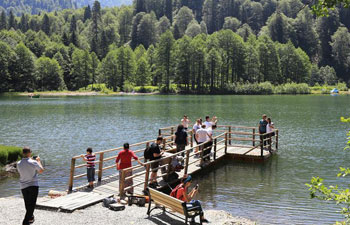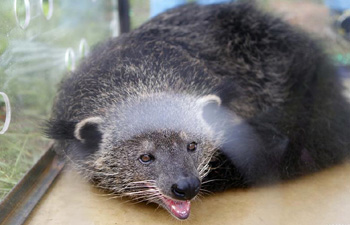SAN FRANCISCO, July 8 (Xinhua) -- New research published Friday in PLOS One shows a species of diatom, a single-celled algae, thought to be asexual, does reproduce sexually.
In addition, among findings of the study, researchers have identified ammonium, a common compound, as the one that puts the ubiquitous organism in the mood.
"Our discoveries solve two persistent mysteries that have plagued diatom researchers," said corresponding author Kimberly Halsey, a microbiologist at Oregon State University (OSU). "Yes, they have sex, and yes, we can make them do it."
There are over 200,000 species of diatoms, and the organisms are abundant nearly everywhere water is found, forming huge blooms in the spring and fall that help drive the marine carbon cycle.
They hold great potential as a bioenergy source and also for biosensing. In addition, their intricate, silica cell walls offer promising nanotechnology applications for materials chemists and drug-delivery researchers.
Halsey and collaborators in botany and statistics from OSU's colleges of Science and Agricultural Sciences studied the "centric" Thalassiosira pseudonana species of diatom, a model organism for researchers; it is one of two diatoms, the other being the "pennate" diatom Phaeodactulum tricornutum, to have had its genome sequenced. Centric diatoms are radially symmetrical and pennate diatoms are bilaterally symmetrical.
"Everybody said Thalassiosira pseudonana was asexual, because they'd never seen anything else. The general thinking was that it just lost the ability or need to go through sex," Halsey was quoted as noting in a news release. "But we started seeing very different morphologies," changes in cell structure, related to sexual activity. "We also saw genes expressed that are involved in flagellar structures and assembly, which would only happen with sperm cells."
In addition, manual, microscopic analysis by the researchers indicated that ammonium, a common compound that's a metabolic waste product of animals, reliably caused two strains of T. pseudonana and two other centric diatoms to change their cell structures, making eggs and sperm; and that the compound caused the diatoms to get ready for sex when at least one other cell growth factor, such as light, phosphorus or silica, was in short supply.
The researchers hailed the findings as a step toward greater understanding of the evolution of sexual behavior.
















